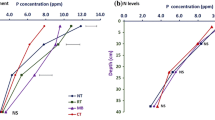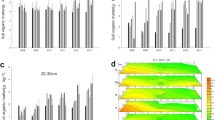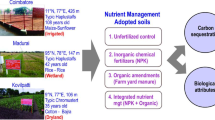Abstract
Due to declining soil quality and increasing climate change, resource conservation technologies are often advocated for the food production system. Conservation agriculture (CA) is one of the technologies that increase soil nutrient status without jeopardizing the soil health and quality. The effects of conservation tillage, residue retention, and cropping systems on soil physical, chemical, and biological properties within the irrigated agricultural system are well established. However, scanty information is available on the combined impact of tillage, residue, and cropping system available on the major and micro-nutrient in the rainfed farming systems. Thus, a field experiment was conducted to measure the short-term effect of CA practices on soil properties and major (N, P, and K) and micro (Fe, Mn, Zn, and Cu)-nutrients in a Vertisol of Central India. The field experiment was laid out in a split-plot design consisting of two tillage systems (TS), conventional tillage (CT) and reduced tillage (RT), as the main plots and six cropping systems (CS) as subplots. A total of 144 soil samples were collected after four crop cycles to assess soil properties and nutrient (major and micro-nutrient) status. Results demonstrated that in the surface soil layer (0–5 cm), the major and micro-nutrient concentrations were higher than subsurface layers, regardless of TS and CS. In the surface soils, soil organic carbon (SOC) varied from 0.58 to 0.60% under CT and from 0.60 to 0.62% under RT. Tillage and cropping systems had a significant effect (p < 0.05) on major available nutrients (N, P, and K) at 0–5-cm depth. The DTPA extractable Fe, Mn, Cu, and Zn concentrations exhibited decreasing trends with increasing depth. At 0–5-cm depth, the DTPA-Fe, Mn, Cu, and Zn under CT varied from 7.56 to 9.58 mg kg−1, 15.04 to 15.91 mg kg−1, 1.37 to 1.80 mg kg−1, and 0.57 to 0.62 mg kg−1 and under RT varied from 8.25 to 11.16 mg kg−1, 15.65 to 17.73 mg kg−1, 1.54 to 1.80 mg kg−1, and 0.59 to 0.67 mg kg−1, respectively. We concluded that RT practices, coupled with crop residue retention, positively affected major and micro-nutrient distribution and availability in this soil. Results highlight the importance of nutrient dynamics under different tillage and cropping systems and thus improve the nutrient recommendation in the semi-arid eco-region of Central India.







Similar content being viewed by others
References
Baker JM, Ochsner TE, Venterea RT, Griffis TJ (2007) Tillage and soil carbon sequestration - what do we really know? Agric Ecosyst Environ 118:1–5. https://doi.org/10.1016/j.agee.2006.05.014
Bhattacharyya R, Tuti MD, Kundu S, Bisht JK, Bhatt JC (2012) Conservation tillage impacts on soil aggregation and carbon pools in a sandy clay loam soil of the Indian Himalayas. Soil Sci Soc Am J 76:617–627. https://doi.org/10.2136/sssaj2011.0320
Blevins RL, Frye W (1993) Conservation tillage: an ecological approach to soil management. Adv Agron 51:34–77. https://doi.org/10.1016/S0065-2113(08)60590-8
Bradford JM, Peterson GA (2000) Conservation tillage. In: Sumner ME (ed) Handbook of soil science. FL, USA, CRC Press, Boca Raton, pp G247–G269
Brady NC (1984) The nature and properties of soils. MacMillan Publishing Company, New York
Busari MA, Kukal SS, Kaur A, Bhatt R, Dulazi AA (2015) Conservation tillage impacts on soil, crop and the environment. Intl J Soil Water Cons Res 3:119–129. https://doi.org/10.1016/j.iswcr.2015.05.002
Dalal RC, Henderson PA, Glasby JM (1991) Organic matter and microbial biomass in a vertisol after 20 year of zero tillage. Soil Biol Biochem 23:435–441. https://doi.org/10.1016/0038-0717(91)90006-6
Dalal RC, Allen DE, Wang WJ, Reeves S, Gibson I (2011) Organic carbon and total nitrogen stocks in a Vertisol following 40 years of no-tillage, crop residue retention and nitrogen fertilization. Soil Tillage Res 112:133–139. https://doi.org/10.1016/j.still.2010.12.006
Das TK, Bhattacharyya R, Sudhishri S, Sharma AR, Saharawat YS, Bandyopadhyay KK, Sepat S, Bana RS, Aggarwal P, Sharma RK, Bhatia A, Singh G, Datta SP, Kar A, Singh B, Singh P, Pathak H, Vyas AK, Jat ML (2014) Conservation agriculture in an irrigated cotton–wheat system of the western Indo-Gangetic Plains: crop and water productivity and economic profitability. Field Crops Res 158:24–33. https://doi.org/10.1016/j.fcr.2013.12.017
Du Preez CC, Steyn JT, Kotze E (2001) Long-term effects of wheat residue management on some fertility indicators of a semi-arid plinthosol. Soil Tillage Res 63:25–33. https://doi.org/10.1016/S0167-1987(01)00227-6
Duiker SW, Beegle DB (2006) Soil fertility distributions in long-term no-till, chisel/disk and moldboard plow/disk systems. Soil Tillage Res 88:30–41. https://doi.org/10.1016/j.still.2005.04.004
Follet RF, Schimel DS (1989) Effect of tillage on microbial biomass dynamics. Soil Sci Soc Am J 53:1091–1096. https://doi.org/10.2136/sssaj1989.03615995005300040018x
Follett RF, Peterson GA (1988) Surface soil nutrient distribution as affected by wheat-fallow tillage systems. Soil Sci Soc Am J 52:41–147. https://doi.org/10.2136/sssaj1988.03615995005200010025x
Franzluebbers AJ, Hons FM (1996) Soil-profile distribution of primary and secondary plant available nutrients under conventional and no tillage. Soil Tillage Res 39:229–239. https://doi.org/10.1016/S0167-1987(96)01056-2
Govaerts B, Sayre KD, Lichter K, Dendooven L, Deckers J (2007) Influence of permanent raised bed planting and residue management on physical and chemical soil quality in rain fed maize/wheat systems. Plant Soil 291:39–54. https://doi.org/10.1007/s11104-006-9172-6
Govaerts B, Verhulst N, Castellanos-Navarrete A, Sayre KD, Dixon J, Dendooven L (2009) Conservation agriculture and soil carbon sequestration: between myth and farmer reality. Crit Rev Plant Sci 28:97–122. https://doi.org/10.1080/07352680902776358
Hanway JJ, Heidel H (1952) Soil analysis methods as used in Iowa state. College soil testing laboratory, Iowa. Agriculture 57:1–31
Hati KM, Chaudhary RS, Mandal KG, Bandyopadhyay KK, Singh RK, Sinha NK, Mohanty M, Somasundaram J, Saha R (2015) Effects of tillage, residue and fertilizer nitrogen on crop yields, and soil physical properties under soybean–wheat potation in vertisols of central India. Agric Res 4:48–56. https://doi.org/10.1007/s40003-014-0141-7
Hulugalle NR, Weaver TB (2005) Short-term variations in chemical properties of vertisols as affected by amounts, carbon/nitrogen ratio, and nutrient concentration of crop residues. Commun Soil Sci Plant Anal 36:1449–1464. https://doi.org/10.1081/CSS-200058489
IARI (2012) Crop residues management with conservation agriculture: potential, constraints and policy needs. Indian Agricultural Research Institute, New Delhi
Jackson ML (1973) Soil chemical analysis. Prentice Hall of India Pvt. Ltd, New Delhi
Jat HS, Datta A, Sharma PC, Kumar V, Yadav AK, Choudhary M, Choudhary V, Gathala MK, Sharma DK, Jat ML, Yaduvanshi NP (2018) Assessing soil properties and nutrient availability under conservation agriculture practices in a reclaimed sodic soil in cereal-based systems of North-West India. Arch Agron Soil Sci 64(4):531–545. https://doi.org/10.1080/03650340.2017.1359415
Kaiser M, Piegholdt C, Andruschkewitsch R, Linsler D, Koch JH, Ludwig B (2014) Impact of tillage intensity on carbon and nitrogen pools in surface and sub-surface soils of three long-term field experiments. Eur J Soil Sci 65:499–509. https://doi.org/10.1111/ejss.12146
Kanwar JS (1976) Soil fertility: theory and practice. ICAR, New Delhi
Kassam A, Friedrich T, Derpsch R, Kienzle J (2015) Overview of the worldwide spread of conservation agriculture. Field Actions Sci Rep 8:1–12 http://factsreports.revues.org/3720
Katyal JC, Sharma BD (1991) DTPA extractable and total Zn, Cu, Mn and Fe in Indian soils and their association with some soil properties. Geoderma 49:165–179. https://doi.org/10.1016/0016-7061(91)90099-F
Khorami SS, Kazemeini SA, Afzalinia S, Gathala MK (2018) Changes in soil properties and productivity under different tillage practices and wheat genotypes: a short-term study in Iran. Sustainability 10:3273. https://doi.org/10.3390/su10093273
Kumar N, Nath CP, Hazra KK, Das K, Venkatesh MS, Singh MK, Singh SS, Praharaj CS, Singh NP (2019) Impact of zero-till residue management and crop diversification with legumes on soil aggregation and carbon sequestration. Soil Tillage Res 189:158–167. https://doi.org/10.1016/j.still.2019.02.001
Kushwa V, Hati KM, Sinha NK, Singh RK, Mohanty M, Somasundaram J, Jain RC, Chaudhary RS, Biswas AK, Patra AK (2016) Long-term conservation tillage effect on soil organic carbon and available phosphorous content in Vertisols of Central India. Agric Res 5:353–361. https://doi.org/10.1007/s40003-016-0223-9
Kushwah SS, Damodar Reddy D, Somasundaram J, Srivastava S, Khamparia SA (2016) Crop residue retention and nutrient management practices on stratification of phosphorus and soil organic carbon under soybean-wheat system in Vertisols of Central India. Commun Soil Sci Plant Anal 47:2387–2395. https://doi.org/10.1080/00103624.2016.1243703
Lal R (2007) Anthropogenic influences on world soils and implications for global food security. Adv Agron 93:69–93. https://doi.org/10.1016/S0065-2113(06)93002-8
Lal R (2013) Enhancing ecosystem services with no-till. Renew Agric Food Syst 28:102–114. https://doi.org/10.1017/S1742170512000452
Lal R, Logan TJ, Fausey NR (1990) Long-term tillage effects on a Mollic Ochraqualf in North-West Ohio.3.Soil nutrient profile. Soil Tillage Res 15:371–382. https://doi.org/10.1016/0167-1987(90)90110-Y
Limousin G, Tessier D (2007) Effects of no-tillage on chemical gradients and top soil acidification. Soil Tillage Res 92:167–174. https://doi.org/10.1016/j.still.2006.02.003
Lindsay WH, Norvell WA (1978) Development of DTPA soil test for zinc, iron, manganese and copper. Soil Sci Soc Am J 42:421–428. https://doi.org/10.2136/sssaj1978.03615995004200030009x
Lopez-Fando C, Pardo MT (2009) Changes in soil chemical characteristics with different tillage practices in a semi-arid environment. Soil Tillage Res 104:278–284. https://doi.org/10.1016/j.still.2009.03.005
Mackay AD, Kladivko EJ, Barber SA, Griffit DR (1987) Phosphorus and potassium uptake by corn in conservation tillage systems. Soil Sci Soc Am J 51:970–974. https://doi.org/10.2136/sssaj1987.03615995005100040027x
Mloza-Banda HR, Makwiza CN, Mloza-Banda ML (2016) Soil properties after conversion to conservation agriculture from ridge tillage in Southern Malawi. J Arid Environ 1(127):7–16. https://doi.org/10.1016/j.jaridenv.2015.11.001
Neugschwandtner RW, Liebhar P, Kaul HP, Wagentristl H (2014) Soil chemical properties as affected by tillage and crop rotation in a long-term field experiment. Plant Soil Environ 2:57–62. https://doi.org/10.17221/879/2013-PSE
Qin RJ, Stamp P, Richner W (2004) Impact of tillage on root systems of winter wheat. Agron J 96:1523–1530. https://doi.org/10.2134/agronj2004.1523
Roldan A, Salinas-Garcia JR, Alguacil MM, Caravaca F (2007) Soil sustainability indicators following conservation tillage practices under subtropical maize and bean crops. Soil Tillage Res 93:273–282. https://doi.org/10.1016/j.still.2006.05.001
Saikia R, Sharma S, Thind HS, Singh Y (2020) Tillage and residue management practices affect soil biological indicators in a rice-wheat cropping system in north-western India. Soil Use Manag 36:157–172. https://doi.org/10.1111/sum.12544
Santiago AD, Quintero JM, Delgado A (2008) Long-term effects of tillage on the availability of iron, copper, manganese, and zinc in a Spanish Vertisols. Soil Tillage Res 98:200–207. https://doi.org/10.1016/j.still.2008.01.002
Schoenau JJ, Campbell CA (1996) Impact of crop residues on nutrient availability in conservation tillage systems. Can J Plant Sci 76:621–626. https://doi.org/10.4141/cjps96-111
Schomberg HH, Steiner JL (1999) Nutrient dynamics of crop residues decomposing on a fallow no-till soil surface. Soil Sci Am J 63:607–613. https://doi.org/10.2136/sssaj1999.03615995006300030025x
Shiwakoti S, Zheljazkov VD, Gollany HT, Xing B, Kleber M (2019) Micronutrient concentrations in soil and wheat decline by long-term tillage and winter wheat–pea rotation. Agronomy 9(7):359. https://doi.org/10.3390/agronomy9070359
Singh RK, Chaudhary RS, Somasundaram J, Sinha NK, Mohanty M, Hati KM, Rashmi I, Patra AK, Chaudhari SK, Lal R (2020) Soil and nutrients losses under different crop covers in vertisols of Central India. J Soils Sediments 20(2):609–620. https://doi.org/10.1007/s11368-019-02437-w
Somasundaram J, Singh RK, Parandiyal AK, Prasad SN (2009) Micronutrient status of soils under different land use systems in Chambal ravines. J Ind Soc Soil Sci 57:307–312
Somasundaram J, Meena HR, Singh RK, Prasad SN, Parandiyal AK (2011) Diagnosis of micronutrient imbalance in lime crop in semi-arid region of Rajasthan. Commun Soil Sci Plant Anal 42:858–869. https://doi.org/10.1080/00103624.2011.552658
Somasundaram J, Reeves S, Wang W, Heenan M, Dalal RC (2017) Impact of 47 years of no-tillage and stubble retention on soil aggregation and carbon distribution in a vertisol. Land Degrad Dev 28:1589–1602. https://doi.org/10.1002/ldr.2689
Somasundaram J, Chaudhary RS, Awanish Kumar D, Biswas AK, Sinha NK, Mohanty M, Hati KM, Jha P, Sankar M, Patra AK, Dalal RC, Chaudhari SK (2018a) Effect of contrasting tillage and cropping systems on soil aggregation, aggregate-associated carbon and carbon pools under in rainfed Vertisols. Eur J Soil Sci 69:879–891. https://doi.org/10.1111/ejss.12692
Somasundaram J, Lal R, Sinha NK, Dalal RC, Chitralekha A, Chaudhary RS, Patra AK (2018b) Cracks and potholes in Vertisols: characteristics, occurrence, and management. Adv Agron 149:93–159. https://doi.org/10.1016/bs.agron.2018.01.001
Somasundaram J, Sinha NK, Mohanty M, Chaudhary RS, Hati KM, Singh RK, Biswas AK, Shukla AK, Dalal RC, Patra AK (2019) Soil hydrothermal regimes as affected by different tillage and cropping systems in a rainfed Vertisol. J Ind Soc Soil Sci 66(4):362–369
Somasundaram J, Sinha NK, Dalal RC, Lal R, Mohanty M, Naorem AK, Hati KM, Chaudhary RS, Biswas AK, Patra AK, Chaudhari SK (2020) No-till farming and conservation agriculture in South Asia – issues, challenges, prospects and benefits. Crit Rev Plant Sci 39(3):236–279. https://doi.org/10.1080/07352689.2020.1782069
Srinivasarao CH, Swarup A, Subba Rao A, Venugopal V (1999) Kinetics of non-exchangeable K release from Tropaquept as influenced by long-term cropping, fertilization and manuring. Soil Res 37(2):317–328. https://doi.org/10.1071/S98049
Srinivasarao CH, Venkateswarlu B, Lal R, Singh AK, Kundu S, Vittal KPR, Patel JJ, Patel MM (2014) Long-term manuring and fertilizer effects on depletion of soil organic carbon stocks under pearl millet-cluster bean-castor rotation in western India. Land Degrad Dev 25(2):173–183. https://doi.org/10.1002/ldr.1158
Subbiah BV, Asija GL (1956) A rapid procedure for the estimation of available nitrogen in soils. Curr Sci 25:518–522
Takkar PN, Mann MS (1975) Evaluation of analytical methods for estimating available zinc and response of maize to applied zinc in major soil series of Ludhiana, Punjab, India. Agrochimica 20:420–430
Walkley A, Black CA (1934) An examination of the Degtjareff method for determining soil organic matter and a proposed modification of chromic acid titration method. Soil Sci 37:29–38
Watanabe FS, Olsen SR (1965) Test of ascorbic acid method for determining phosphorus in water and sodium bicarbonate extracts of soils. Proc Soil Sci Soc Am J 29:677–678
Acknowledgments
The first author sincerely thanks Dr. A. Subba Rao, Former Director, ICAR–Indian Institute of Soil Science, Bhopal, for his guidance in taking up this research project. We thank Mr. R.K. Mandloi, Mr. P.K. Chouhan, technical officers, and Mr. Hukum Singh, field assistant, for their assistance in field experimentation and soil sampling. We also thank Mr. Sahab Siddiqui and senior research fellows for their assistance in soil sample analysis.
Author information
Authors and Affiliations
Corresponding author
Ethics declarations
Conflict of Interest
The authors declare that there is no conflict of interest.
Additional information
Publisher’s note
Springer Nature remains neutral with regard to jurisdictional claims in published maps and institutional affiliations.
Supplementary Information
ESM 1
Table S1 Effect of cropping system on pH, SOC, major nutrients after four crop cycles under conventional tillage system. Table S2 Effect of cropping system on pH, SOC and major nutrients after four crop cycles under reduced tillage. Table S3 Effect of conventional tillage and cropping system on DTPA-extractable Fe, Mn, Zn and Cu after four crop cycles Table S4 Effect of reduced tillage and cropping systems on DTPA-extractable Fe, Mn, Zn and Cu after four crop cycles. Table S5 Results of principal component analysis (PCA) (DOCX 42 kb)
Rights and permissions
About this article
Cite this article
Jayaraman, S., Sinha, N.K., Mohanty, M. et al. Conservation Tillage, Residue Management, and Crop Rotation Effects on Soil Major and Micro-nutrients in Semi-arid Vertisols of India. J Soil Sci Plant Nutr 21, 523–535 (2021). https://doi.org/10.1007/s42729-020-00380-1
Received:
Accepted:
Published:
Issue Date:
DOI: https://doi.org/10.1007/s42729-020-00380-1




